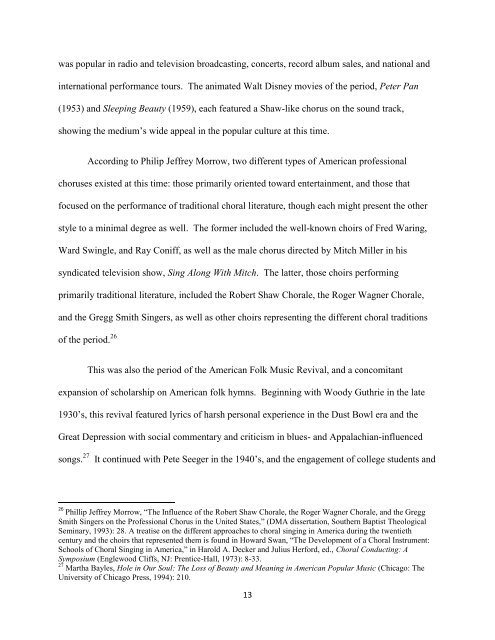THE COLLABORATIVE ARRANGEMENTS OF ALICE PARKER AND ...
THE COLLABORATIVE ARRANGEMENTS OF ALICE PARKER AND ...
THE COLLABORATIVE ARRANGEMENTS OF ALICE PARKER AND ...
Create successful ePaper yourself
Turn your PDF publications into a flip-book with our unique Google optimized e-Paper software.
was popular in radio and television broadcasting, concerts, record album sales, and national and<br />
international performance tours. The animated Walt Disney movies of the period, Peter Pan<br />
(1953) and Sleeping Beauty (1959), each featured a Shaw-like chorus on the sound track,<br />
showing the medium’s wide appeal in the popular culture at this time.<br />
According to Philip Jeffrey Morrow, two different types of American professional<br />
choruses existed at this time: those primarily oriented toward entertainment, and those that<br />
focused on the performance of traditional choral literature, though each might present the other<br />
style to a minimal degree as well. The former included the well-known choirs of Fred Waring,<br />
Ward Swingle, and Ray Coniff, as well as the male chorus directed by Mitch Miller in his<br />
syndicated television show, Sing Along With Mitch. The latter, those choirs performing<br />
primarily traditional literature, included the Robert Shaw Chorale, the Roger Wagner Chorale,<br />
and the Gregg Smith Singers, as well as other choirs representing the different choral traditions<br />
of the period. 26<br />
This was also the period of the American Folk Music Revival, and a concomitant<br />
expansion of scholarship on American folk hymns. Beginning with Woody Guthrie in the late<br />
1930’s, this revival featured lyrics of harsh personal experience in the Dust Bowl era and the<br />
Great Depression with social commentary and criticism in blues- and Appalachian-influenced<br />
songs. 27 It continued with Pete Seeger in the 1940’s, and the engagement of college students and<br />
26 Phillip Jeffrey Morrow, “The Influence of the Robert Shaw Chorale, the Roger Wagner Chorale, and the Gregg<br />
Smith Singers on the Professional Chorus in the United States,” (DMA dissertation, Southern Baptist Theological<br />
Seminary, 1993): 28. A treatise on the different approaches to choral singing in America during the twentieth<br />
century and the choirs that represented them is found in Howard Swan, “The Development of a Choral Instrument:<br />
Schools of Choral Singing in America,” in Harold A. Decker and Julius Herford, ed., Choral Conducting: A<br />
Symposium (Englewood Cliffs, NJ: Prentice-Hall, 1973): 8-33.<br />
27 Martha Bayles, Hole in Our Soul: The Loss of Beauty and Meaning in American Popular Music (Chicago: The<br />
University of Chicago Press, 1994): 210.<br />
13
















